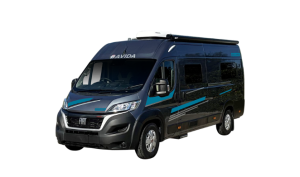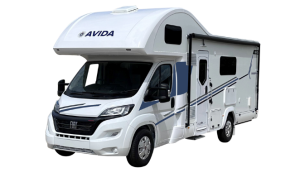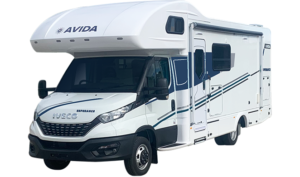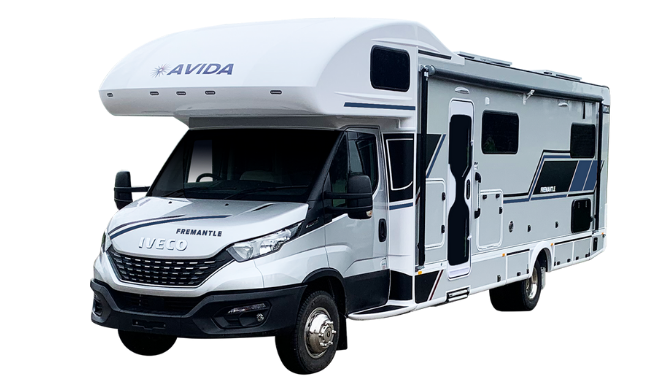Release written by Rod Chapman – Caravan and Camping Sales
Considering your first truck-based motorhome? Read this first…
Anyone stepping up to a truck- or coach-based motorhome has plenty to consider. The eye-watering purchase price of a typical A Class or C Class monster will soon weed out the tyre-kickers, while for those unperturbed it shouldn’t be forgotten that the on-going running costs will also take a sizeable chunk out of the holiday budget.
Of course, anyone with a standard car licence will soon find that, for vehicles with a Gross Vehicle Mass (GVM) of over 4500kg, they’ll need a truck licence – either a light rigid (LR), medium rigid (MR) or heavy rigid (HR) qualification depending on the GVM of the RV, or even a heavy combination (HC) licence for those wishing to drive a prime mover and a converted trailer (rare in Australia, it has to be said).
THOSE IN THE KNOW
Caravancampingsales spoke with Billy Falconer, Dealer Development / Sales and Marketing Manager at Avida, to learn more about the perceived obstacles to moving up to a truck-based motorhome.
Avida can trace its roots back to 1965, and today manufactures a wide range of caravans, campervans and motorhomes. While most of its motorhomes can be driven on a standard car licence, its Torquay model requires a light rigid licence and its Longreach (see the caravancampingsales review here) requires a medium rigid licence.
Avida says these two models account for roughly 12 per cent of its annual motorhome sales, but that’s not so surprising – with recommended retail prices of $191,990 (Torquay) and $272,990 (Longreach), these RVs aren’t for those just looking for the odd weekend away…
Billy says these high-end RVs attract a typical sort of buyer.
“For our Longreach, for example, it’s generally people who are in their retirement – they’ve sold up and it becomes their home,” he says.
“That’s the case for the majority of Longreach buyers. There’s just more space – it’s very easy to live in because it’s a large motorhome. It becomes their home on wheels.”
So it’s the grey nomads leading the charge here, rather than couples with kids, and according to Avida these buyers are pretty evenly split between RV veterans and first-timers.
So, what are the pros and cons of jumping into the heavy end of the motorhome spectrum? Being glass-half-full types ourselves, let’s first consider the benefits…
LAP OF LUXURY
Topping the list would have to be comfort. With masses of space comes masses of room to move – bigger bedrooms, a full ensuite, larger living areas, a kitchen with all the mod-cons – and plenty of payload to carry all the gear. We’re not just talking about all the clothing and miscellaneous items you want to take on the road, either, but bulk payload to carry heavy appliances like washing machines, dryers – even generators and barbecues.
With a length of over 9.5m, rest assured the Longreach isn’t left wanting when it comes to space. With a GVM of 8700kg and a Gross Combined Mass (GCM) of 12,200kg, the Longreach can also tow a small car – an invaluable thing when it’s time to duck into town for some shopping.
The GVM is the maximum weight the vehicle must not exceed when fuelled and loaded (as opposed to the tare weight, which is essentially the unladen weight of the vehicle, sans liquids – fuel, water, oil etc). The GCM, then, is the maximum weight of the loaded and fuelled vehicle plus the weight of whatever it’s towing.
Other benefits include being self-sufficient. Large roofs provide acres of space for big solar setups, not that you’ll be heading off-road and off-grid in anything less than a 4WD behemoth – think MAN TGM 4×4, Mercedes-Benz Unimog and Iveco Eurocargo 4×4, for example.
But at the very least, in something like a Longreach you’ll have everything you could want at your disposal, from power slide-outs to hidden flat-screen TVs, full-size ovens, spacious showers and more. It’s luxury that simply can’t be replicated on a smaller, sub-4500kg GVM scale. As Billy says, these big rigs “really do take things to the next level”.
Finally, consider the typically strong resale value of a large motorhome. Serviced as per the schedule and looked after with care, your investment shouldn’t put you too far down the hole when it comes time to sell. According to Billy, a well-cared-for rig shouldn’t hold any nasty surprises…
“I don’t get involved with used products but the feedback I get from dealers is that generally the bigger motorhomes hold very good resale value.
“It comes down to supply and demand too. With your standard car licence motorhome there are many more of those on the road, but with these larger ones there aren’t as many on the road and so they hold their value well.”
BIG RIG, BIG DOLLARS
On the negative side of the ledger is the sheer size and dimensions of these kings of the road. If you’re not use to driving large trucks, Billy says it’s the biggest concern for those in the market.
“If you’ve got someone who’s got a bit of experience with driving big trucks it’s all fine, but the initial concern for the others is the fear of the unknown of driving a big product,” he says.
“However, if they don’t currently hold the required licence, what’s required to go and get that done isn’t too hard – it’s more the fear of driving such a big product and being comfortable with it if you haven’t done it before.”
Depending on where you live, obtaining a truck licence could entail upgrading your current licence after spending some time in a heavy vehicle, or it could mean completing a formal course.
A quick Google search will reveal any number of truck driver training companies in capital cities and most major regional centres willing to guide you through the process. Having done so myself a few years back – I now hold a heavy combination (HC) licence – I can say it’s nowhere near as daunting as you might think.
Requirements vary from one state to another, however, so take a look at the transport department links below:
Registered training organisations (RTOs) generally offer a range of licence courses, from one-on-one tuition to group classes, and accelerated one or two-day programs to courses lasting one or two weeks – with varying fees to suit.
A couple of points to bear in mind here: chances are you’ll only need a ‘synchromesh’ licence unless you plan on driving a prime mover with an 18-speed Roadranger gearbox, so do a synchromesh licence course.
These transmissions work just like those in a manual passenger car, and so the course is far easier than learning to master a non-synchromesh ‘box, which requires double-shuffling and matching the engine speed with your road speed to change gears. To read more about my truck licence journey, click here and here.
Also, think about where your large motorhome journey may take you. If you’re buying a rig requiring a light rigid licence but plan to move up to a medium or even heavy rigid vehicle down the track, do the highest licence course you think you’ll need, so you don’t have to go through the process all over again.
I wouldn’t recommend the compressed courses, either – the more time you spend in a heavy vehicle with an instructor beside you, the more comfortable you’ll feel when you get behind the wheel of your own large motorhome.
SIZE MATTERS
Acclimatising to your rig’s size and weight actually doesn’t take long, but you will come up against other issues. Parking, especially in built-up areas, has its challenges – the more external cameras you can fit the better to help smooth the way.
You’ll need to be aware of the travel height of your RV, and how that will change if you fit anything on the rig’s roof. There are many truck-based sat-nav systems available these days that allow you to enter the vehicle dimensions and then chart a course to suit, avoiding low bridges.
Of course larger, heavier vehicles generally incur higher registration costs – this again will vary from state to state – and big rigs also incur big fuel bills. No, we’re not talking about the $2000 fuel bills faced by interstate truckies, but more than you might think. Ask the dealer and do your research.
Using the Longreach as an example, its Isuzu 5.2-litre four-cylinder turbo-diesel should be good for around 22L/100km, but it all depends on how big a load it’s carting and, for those crossing ‘the paddock’ (the Nullarbor), whether you’re working with the wind (heading east) or against the wind (heading west).
Of course, some may be put off by the sheer length of a large motorhome’s features list. While second-hand buyers should ask for a detailed walkaround with the seller to learn how to operate their rig (recording this can be very handy), Billy says Avida customers are well looked after as a matter of course.
“We’ve got dealers spending around four hours on a handover – the detail of the operation and how it all works – and they also get an Avida bag with a ‘how to’ guide,” he says.
“There’s a lot of time spent making sure that they’re comfortable when they go out on the road in one of these products. Even if it’s someone that’s now looking at buying, they’ll explain what’s required to upgrade your licence – how it’s not as daunting as people may think it is.”
So there you have it: a basic ‘nuts and bolts’ expose on getting behind the wheel of an A Class or C Class motorhome. If you simply have to have the extra space and added luxury, and the added expense isn’t a problem, don’t let any perceived driving and licencing issues deter you from taking the plunge.
THE LAST WORD
On that note, we’ll let Avida’s Billy Falconer have the last say…
“I’d say go and see your local dealer and have a chat with them; the fears you may have of getting into a larger motorhome can be pretty quickly overcome once you find out the facts,” he says.
“It’s not something to be feared; by all accounts from our customers it’s a great experience, life changing even.”
Take a 3D tour of the Avida Longreach
See Caravan and Camping Sales photos and article here









